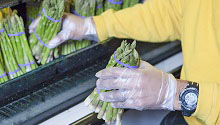December 18, 2012 – Arlington, VA – Food Marketing Institute (FMI) and Feeding America today released a report underscoring the critical contribution food retailers make to their respective communities through their support of local food banks. The study, “Decades of Donations: The 2012 Survey of the Food Retail Industry’s Support of Food Banks,” is a collaborative effort between FMI, representing U.S. food retailers, and Feeding America, the nation’s leading network of food banks. The document substantiates how critical food banks are to the nation’s anti-hunger support system and reports that U.S. grocery stores are the top donation stream for Feeding America’s network of food banks.
“More than 50 million Americans, including 17 million children, are at risk of hunger,” said Bob Aiken, president and CEO of Feeding America. “Families across the country are struggling to make ends meet, there is the possibility of billions of dollars in cuts to the SNAP program, and food banks are working harder than ever to serve the needs of hungry families in their communities. This is why the substantial donations we receive from the nation’s food retailers are so critically important in helping us provide food to nearly six million Americans each week.”
According to Feeding America, food banks experienced a 46 percent increase in clients between 2006 and 2010. Consequently, 99 percent of all retailers who responded to the FMI survey indicated they support a food bank by donating food. Over one-fifth (21 percent) of retailers reported donating more than 1 million pounds of food, and more than one-third (36 percent) donated at least 100,000 pounds. Reporting in 2012 on contributions made in 2011, 96 percent of retailers donated cash to food banks. Of those who donated cash, 26 percent contributed more than $100,000, last year. Cash contributions to food banks enhance their ability to supplement product categories in need, such as fresh meat, where donations do not meet the demand.
“Our 2012 consumer trends research showcased how U.S. consumers have adapted to living with less, but many American families struggle with severe economic restrictions that limit their food options,” said Leslie G. Sarasin, president and CEO of FMI. “Grocery stores and supermarkets across our nation are proud to partner effectively with local food banks, providing families in need with affordable quality nutritious food.”
The report covers the product categories; challenges in supply that food retailers and Feeding America are working to collectively address; and alternative ways in which food retailers assist food banks, such as food drives, scannable coupons that assist local banks, and even necessary equipment to expand and enhance a food bank’s network.
Sarasin continued, “Food retailers have a longstanding tradition of being actively involved in their respective communities. By assisting food banks and enabling their customers to join in that effort, food retailers extend the reach of that neighborhood support to those in need of basic nutritional sustenance.“
For Media:
Copy of “Decades of Donations: The 2012 Survey of the Food Retail Industry’s Support of Food Banks”
Photos courtesy of the Washington, DC Capital Area Food Bank
Copy of “2012 U.S. Grocery Shopper Trends” Report
 Industry Topics address your specific area of expertise with resources, reports, events and more.
Industry Topics address your specific area of expertise with resources, reports, events and more.
 Our Research covers consumer behavior and retail operation benchmarks so you can make informed business decisions.
Our Research covers consumer behavior and retail operation benchmarks so you can make informed business decisions.
 Events and Education including online and in-person help you advance your food retail career.
Events and Education including online and in-person help you advance your food retail career.
 Food Safety training, resources and guidance that help you create a company food safety culture.
Food Safety training, resources and guidance that help you create a company food safety culture.
 Government Affairs work — federal and state — on the latest food industry policy, regulatory and legislative issues.
Government Affairs work — federal and state — on the latest food industry policy, regulatory and legislative issues.
 Get Involved. From industry awards to newsletters and committees, these resources help you take advantage of your membership.
Get Involved. From industry awards to newsletters and committees, these resources help you take advantage of your membership.
 Best practices, guidance documents, infographics, signage and more for the food industry on the COVID-19 pandemic.
Best practices, guidance documents, infographics, signage and more for the food industry on the COVID-19 pandemic.
